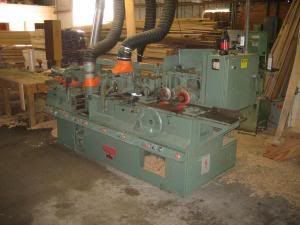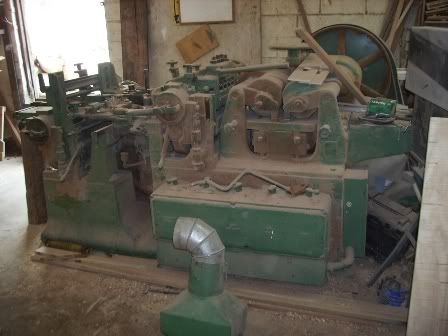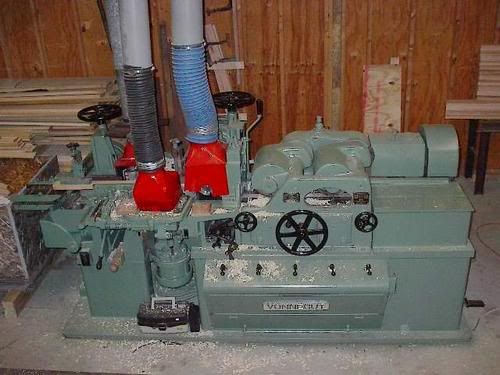cadas
Full Member
  
Posts: 107
|
Post by cadas on Mar 8, 2008 19:08:52 GMT
Knowing how gullible I am when faced with large amounts of green painted cast iron, someone has just offered an old six head moulder (plus a seventh head module for the end)
It is being given away, I've only got to relocate it.
It has been used for floorboard production until recently and comes with boxes and boxes of tooling.
Is this one machine too far? Or is it practical to use it day to day for turning out blanks such as spindles, handrails, window/door sections, etc.
My worry is that it is such a beast that it will take a day to set up each time I want to cut 20 spindles. I was thnking of just setting it up with straight cutters and using it to turn out blanks of various sizes.
|
|
|
|
Post by Scrit on Mar 8, 2008 21:17:37 GMT
Depends on what it is and how old it is. If it's pre-1980 it's likely to be one of the older designs such as the FD with 6,000 rpm heads - the later machines are more often fitted with15,000 rpm router spindle heads and generate a much cleaner surface finish. Either way the liklihood is that it won't be a lightweight - the 6 head 8 x 4in FD (in production from the 1950s until the 1970s) weighs a mere 7.1 tonnes, the larger 12-1/2 x 6-1/2in model comes in at 8.3 tonnes. So not something to nip round in the Tranny to pick up..........  The other question is, how much will your TP&N distibution board handle? The 12-1/2 x 6-1/2in machine draws 37.5kW (47kVA) or a piffling 90 Amps. Tthese machines make CNC routers seem positively frugal by comparison So, which model is it? Scrit |
|
|
|
Post by jfc on Mar 8, 2008 21:50:03 GMT
Does it have a 240V plug on it ? ;D
|
|
|
|
Post by Scrit on Mar 8, 2008 22:46:32 GMT
Course it does. Best darned pencil sharpener on the planet!
|
|
|
|
Post by jfc on Mar 8, 2008 23:48:39 GMT
Bring back Concord i say ! With that flying over my house i could start that baby up twice a day and run down the garden screaming like a girl
|
|
|
|
Post by engineerone on Mar 9, 2008 0:05:03 GMT
hell of a way to make firewood  ;D paul  |
|
cadas
Full Member
  
Posts: 107
|
Post by cadas on Mar 9, 2008 6:28:46 GMT
It looks similar to the one in the photo, but dark green. It has had pneumatic feed fitted to the front end.
All of the air supply and the electrical gear are in separate boxes.
The vendor reckons it weighs four tonnes ish but it did look heavier to me.
Power sounds a bit heavy, I'd need to get EDF to up the supply.
All in all proably not worth it, Ill keep saving for a lightweight 4 head such as an SCM.
Ta
|
|
cadas
Full Member
  
Posts: 107
|
Post by cadas on Mar 9, 2008 6:32:26 GMT
Just noticed one difference from the photo, this one has forklift fork slots at the bottom on the R/H side, this is how the seller claims to have moved it.
Mind you, this is also the bloke I got the Whites Speedsander from and I haven't managed to get that working properly yet.
|
|
|
|
Post by Scrit on Mar 9, 2008 10:51:16 GMT
If he reckons it weighs 4 tonnes, then it ain't an FD or its' predecessors the FB or FC (assuming he's got the weight right). Wadkin did make two other ranges of 4-siders in the 1950s and 1960s - the 7 x 4in type AGC at around 2.7 tonnes which are a lot shorter and the 4-1/2in x 3in BFO at around 1.5 tonnes, although they were only 4- or 5-head designs. I suppose it might be a later model like the GA or XE, both available in 6-head format, however both of those designs were arranged to be lifted by passing lifting rods through the base of the chassis in much the same way you do when moving CNC routers. It might help if you could either post a photograph or at least get me a model/type reference to work from.
Scrit
|
|
|
|
Post by oldjoiner on Mar 9, 2008 16:17:49 GMT
You must first determine if this is a "though-feed", or more lightly, a "push-feed" machine.
The through-feed machine will do as it's name suggests, and feed like a thicknesser.
The push-fed machines have a large pair of serrated feed rolls at the in-feed end. The other pressure rollers through the machine are non driven idlers. This means the last piece of stock cannot exit the machine. Heads, rolls etc. are backed off to remove piece, which is put one side, to use as a setting piece. It is then placed back in the machine, heads brought in to touch. This becomes the first piece of the next batch. Not a machine for small runs, or jobbing.
JohnB
|
|
|
|
Post by Scrit on Mar 9, 2008 17:33:25 GMT
John
Did Wadkin ever make a push feed machine? All the literature I've seen from Vonnegut-period machines (1930s) onwards appear to have been the through feed type with several drive rollers through thye machine. Bursgreen, on the other hand, did make some push-feed machines such as gang saws, etc. in Sagar days
Scrit
|
|
cadas
Full Member
  
Posts: 107
|
Post by cadas on Mar 9, 2008 17:45:03 GMT
I think it is a modified FD, the pneumatic feed was added later, plus there is a seventh head module, they were doing floorboards with it, ie top, bottom, left, right, then top bottom again, plus shaping for decking.
The only differences from your photo scrit is the infeed end, no curved lump, just two big infeed rollers, plus these two fork lift slots just under the bit that says Wadkin on your photo.
I will try and get up there for a photo, but it does look remarkably similar to the photo but perhaps a bit more squared off, and dark green. Could be the later model as I remember he installed using an old Manitou forklift and he transported it on a 7.5tonne, but the boxes and extra heads came separately. But there were definately two fork slots at the right hand end.
I know it is 1600mm deep, and about 3.5m long
Other things he said, all the heads have vernier adjustment,
So much cast iron...............so little time
|
|
|
|
Post by Scrit on Mar 9, 2008 19:06:55 GMT
The domed bit at the infeed end was common to both the FD and it's earlier sister machine range, the FJ and actually contains the infeed power feed rollers, so if yours has been modified to have pneumatic feed than that might explain the differences in appearance. The only major differences between the FD and the FJ were the ordering of the heads. FDs always start with a bottom head (British/European practice) whilst FJs start with a top head (American practice). The permutations after that were legion because most machines were built to order...... Wadkin did, incidentally, manufacture a smaller 4 x 4in FD/FJ in the fifties and early sixties which weighed in at approximately 3.4 tonnes in 4/5-head format although no doubt there's someone out there running a 7-head machine somewhare (maybe even yours ;D). Of course the other possibility is that it might be another machine, the later FB. Here's a later type FB (made from the early 1970s until approx. the 1990s) for comparison (note the infeed cover is very boxy):   This one has a later (1970s) Wadkin badge and is actually an FB122, although my understanding is that there was originally an FB made from 1930 until about 1949 which was completely different (Wadkin recycled the FB name and well as the FD name on later machines). That FB appears to have been the American Vonnegut machine made under licence and offered in 3 sizes: 4 x 4in, 7 x 4in and 12 x 4in. The earliest machines actually had the Vonnegut "V" trademark and the name "Vonnegut - Indianapolis" cast into the side despite being made enitirely in Leicester. For comparison here is a photographs of a 1930s period Vonnegut moulder (the Wadkin built examples were ostensibly the same apart from the shape of the British motors and some details of the switch gear):  These machines were first made to order for the London & North Eastern Railway Company and follow the American practice of top head first (as opposed to the European approach of bottom head first). They marked Wadkin's entry into the moulder market and production certainly ceased around 1949, the year in which ownership of the original Vonnegut company passed to Diehl in the USA (and inventor of the high speed moulder) and Wadkin presumably lost their licence. They were making major inroads into the US market at the time so that would seem logical The later production Vonneguts looked like the following example, although I cannot say if Wadkin followed the design changes. Note that the very large infeed drive pulley wheel has now disappeared:  Because these machines are so uncommon in the UK I hazarded a guess that your machine would probably be one of the much more common FD/FJ variants As to power consumption, most heavyweight moulders seem to run heads in the 7.5 to 10HP range, at least in 7 x 4in and larger versions, so a 7 head machine will be a bit heavy on electric, not to mention requiring a substantial dust extraction unit (500 to 1000 cfm per head). Oh, and I almost forgot to mention - these are possibly the noisiest woodworking machines on the planet with the possible exception of the modern ultra high speed head machines so you might just need to build a soundproof cabinet for the thing if you do get it. I hope that the foregoing is of interest. Scrit |
|
cadas
Full Member
  
Posts: 107
|
Post by cadas on Mar 10, 2008 5:33:18 GMT
Thats it, it's an FB, it has the two square holes plus the row of buttons along the front.
I think it's a no go, if I had unlimited space and had no neighbours then it would probably be worthwhile.
Thanks Scrit
|
|